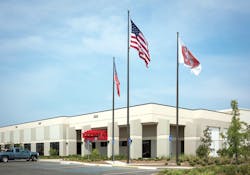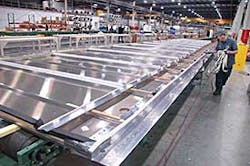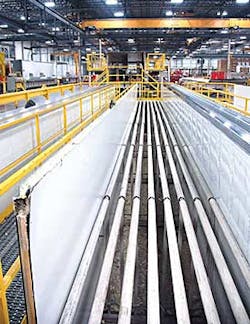It’s lean. It’s green. And Great Dane’s new refrigerated trailer plant is hitting its stride
A CLEAN SHEET of paper and decades of manufacturing experience can produce a state of the art trailer manufacturing plant.
In the case of the Great Dane’s new refrigerated trailer plant in Statesboro, Georgia, one of America’s oldest trailer manufacturers had the opportunity to pick out the best of what it has learned over the years and put that expertise under the 450,000-sq-ft roof of America’s newest truck trailer production facility.
But not at the expense of new ideas.
Experience may be the basis for the plant’s foundation, but Great Dane also has implemented a number of fresh ways to improve quality and efficiency in its new facility. If those concepts prove as successful as management anticipates, they will be replicated at other Great Dane manufacturing plants around the country.
Besides Statesboro, Great Dane builds refrigerated trailers in Brazil, Indiana and Wayne City, Nebraska. Some of the technology is specific to reefer trailer production. Other concepts, however, can be applied just as well to dry freight and even platform trailer production.
“We concentrated on ways to improve our workflow and to automate production,” says Michael Chitty, sales engineering for Great Dane. “Some of the machines we have developed here will almost certainly be used elsewhere in our company.”
Great Dane had several objectives in mind when designing the new facility. They include efficiency, product quality, environmental concerns, and ergonomics.
To achieve these objectives, Great Dane relied heavily on automation and designing the plant in a way that minimizes the distance that raw materials, subassemblies, and components must travel. The company also took aim at improving material handling. To illustrate the point, the company’s Savannah plant (now closed) required raw material, fabricated parts and components to travel between multiple buildings, resulting in excess travel of part during the assembly process, which was reduced by a factor of nine in the Statesboro facility.
Great Dane is beginning to harvest the fruit of its ideas. Management has allowed the plant to gradually ramp up production following last year’s grand opening. The plant built its first custom trailer late last summer for Rowland Transportation of Dade City, Florida. Throughout the fall and winter, assembly increased as employment grew and the new workforce became increasingly familiar with the new plant layout and its technology that includes robotic welding and automated foaming.
Production is definitely building momentum, especially with Great Dane’s receipt of a 200-unit order for Celadon. The plant is approaching its capacity—50 refrigerated trailers per week with one shift. While the plant still has room to grow, it’s well on its way toward targeted production of 100 trailers per week at full two shift capacity.
First major order
The building includes 12,000 square feet of office space and a 3,000-sq-ft climate-controlled customer preview center. The Statesboro plant is tooled to manufacture Great Dane’s new Everest refrigerated trailers, the TL model reefer for truckload carriers and the CL model reefer built especially for the needs of multi-temp and foodservice operations, especially those in the Southeast.
The Statesboro plant received a big boost recently with the receipt of a 200-unit order from Celadon. The plant completed the first unit last month. The reefers represent the first refrigerated trailers that Celadon, one of North America’s largest truckload carriers, has purchased from any manufacturer.
“These trailers will enable Celadon to expand its customer service by hauling temperature-controlled freight in addition to its already wide range of services,” says Dave Gilliland, Great Dane’s vice-president of national accounts.
The reefer trailers being built for Celadon are based on Great Dane’s Everest TL model. The fleet also specified ThermoGuard reefer liner, which features a patented metal barrier layer in the sidewalls, ceiling and floor subpan to minimize thermal degradation of the trailer’s insulation over time. Other features of Celadon’s customized Everest TL order include a wedge design for maximum rear opening height, Hendrickson HD air ride suspension, Bridgestone R197 Ecopia tires, Transtex side skirts, Carrier 2100 APX reefer unit with auto fresh air exchange and Intelliset temperature control, rear door switch, StarTrak GPS, side air chute, air return bulkhead and pallet stops. The trailers are also designed for occasional rail usage. The Statesboro plant was scheduled to complete the 200-trailer order at the end of July.
Losing lost motion
One of the focal points of plant design was the efficient flow of materials through the plant. Statesboro accomplishes that in several ways.
Perhaps most importantly, Great Dane had the luxury of designing the plant starting with a clean slate. With no existing barriers to design around, the company drew up what is essentially a square 450,000-sq-ft structure. Within that square, engineers placed an L-shaped assembly line. The trailer assembly line starts along the back wall of the plant. Assembled vans then turn 90 degrees as the assembly line flows along the adjacent wall and back toward the front of the building.
Subassemblies flow from the front of the plant to the trailer assembly line. The termination point for each of these subassemblies is the exact spot on where they are needed on the assembly line.
Likewise, raw materials are delivered and unloaded close to where they are needed for subassemblies. The plant has two sets of doors for deliveries—one set near the start of subassembly production through which about 70% of materials and components enter the facility. A second set of doors primarily feeds materials used for floor assemblies.
The work generally flows in a straight line. Supplied parts are kept in a supermarket inside the plant, slashing the amount of motion inherent in any sort of outside storage. The company continues to work on ways to reduce inventories. Part of that is in improving real-time communications. To help in that area, computer monitors are being installed on the plant floor to enable production workers to view drawings and specifications in order to improve accuracy and reduce lost time.
Automating trailer insulation
Great Dane shopped the world to develop specialized equipment for producing its trailers, including its proprietary foaming system.
“Foaming is a very sensitive operation,” Chitty says. “We have conducted studies on how fast foam rises, what the variables are, and exactly how much foam is ideal for the predefined cavities that we must insulate. We know what is required and have equipment in place to automate the process so that it’s done accurately and consistently. Under controlled conditions, each cavity is automatically injected with the exact amount of foam required to fill it.”
That, of course, is only part of the foaming process. Mixing of the foam components is important, as is temperature control. Equally vital is to hold the walls in place so that bulges are eliminated and the surface is perfectly flat.
The foaming presses at the Statesboro plant are designed to resist the several hundred tons of force generated during the foaming operation. They are 60 feet long, giving Great Dane the capability of manufacturing a 60-ft-long trailer or sidewalls for two 28-ft pups.
Other automation
An array of other devices helps move trailers through the line:
- A robotic work cell automates the welding of rear door frames, and gantry-mounted guns take the work out of welding reefer flooring. These operations are remotely monitored and adjusted as required.
- Automated rivet inserting has been both a bane and a dream for van trailer manufacturers. But the equipment Great Dane has in Statesboro has been performing reliably, enabling conveyors to carry sidewalls filled with rivets to the rivet press for upsetting.
- Automated torque equipment tightens lug nuts and U-bolts to required specifications. The system monitors and records actual torque specifications, generating a record of the torque applied on each trailer serial number at the time it was assembled.
- Trailers move from one workstation to the next on conveyors to workstations throughout the plant.
- “Air skates,” which use a thin cushion of compressed air to virtually eliminate friction, move trailers through areas where such devices offer advantages over the conveyor line. The air skates provide exceptional maneuverability, enabling one person to move a trailer 90 degrees if necessary.
Going green
Another design objective for the Statesboro plant was to make it easy on the environment—and human beings.
“We try to recycle 100% of what we don’t use,” Chitty says.
The plant has different colored dumpsters for the various types of scrap that the plant generates, including mild steel, stainless, and aluminum. These containers supplement conventional refuse containers.
Other features include:
- A building management system to automatically control lights, air quality and building temperature.
- The use of load monitors to ensure optimal energy consumption.
- Extensive use of energy-saving compact fluorescent bulbs
- A water reclamation system for the wash bays.
- Evaporative coolers add comfort in the plant on summer days, dropping temperatures 15 degrees from ambient but without the extensive electrical consumption of standard air conditioning systems.
- Four large fans change the air inside the plant every 15 minutes.
Plenty of planning
The plant is the result of a lengthy planning process. Once the plans were complete, the plant became reality relatively quickly. The grand opening was held a little more than a year after Great Dane broke ground on the 118-acre site.
“We are thrilled to finally open the doors of our brand new production facility here in Statesboro,” president and chief executive officer Bill Crown said at last year’s opening ceremonies.
He pointed out that during the planning process, the trailer industry suffered through its most significant downturn in a generation.
“This building reflects the diligence and focus of countless individuals over the past two years, working together toward this day in some of the most difficult economic times we can remember,” he said. “This plant sets a new standard for cutting-edge manufacturing and efficiency. We are proud that it will serve as a model of the most technologically advanced, environmentally sound production practices in the world.”
Why Statesboro?
Great Dane’s newest manufacturing facility is built on a 118-acre site in Bulloch County, just 50 miles from the company’s roots in Savannah, Georgia. The location was selected for a variety of reasons, including its economy. As the state unemployment rate hovers above eight percent, the plant will bring more than 400 greatly needed jobs to the area.
Statesboro was selected for several reasons including availability of suitable space, easy access to the Interstate highway, and access to a qualified workforce (without heavy competition from other manufacturing concerns).
Its proximity to Savannah, however, was a key factor in selecting Statesboro. Although Great Dane stopped manufacturing trailers in Savannah in 2009, corporate offices remain there, including sales, marketing, customer service, administration, and engineering, along with research and development functions. The company has further committed to the Savannah area by breaking ground on a new research and development campus, on the existing corporate office facility in Savannah.
“Before we discontinued manufacturing in Savannah, we had previously stopped producing dry vans here around 2001 due to the availability of five other strategically located Great Dane van plants across the US,” says Brandie Fuller, vice-president. The plan for Statesboro was to keep a reefer manufacturing presence in the Southeast…our historical home market.” ♦
__________________
Click here to view all large photos and captions
for Great Dane's new refrigerated trailer plant
About the Author
Bruce Sauer
Editor
Bruce Sauer has been writing about the truck trailer, truck body and truck equipment industries since joining Trailer/Body Builders as an associate editor in 1974. During his career at Trailer/Body Builders, he has served as the magazine's managing editor and executive editor before being named editor of the magazine in 1999. He holds a Bachelor of Journalism degree from the University of Texas at Austin.








